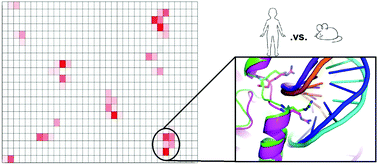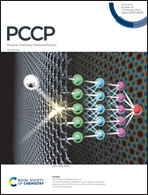DNA-binding mechanisms of human and mouse cGAS: a comparative MD and MM/GBSA study†
Abstract
Cyclic GMP–AMP synthase (cGAS) can detect the presence of cytoplasmic DNA and activate the innate immune system via the cGAS–STING pathway. Although several structures of cGAS–DNA complexes were resolved recently, the molecular mechanism of cGAS in its recognition of DNA has not yet been fully understood. In order to reveal the subtle differences between human and mouse cGAS in terms of their DNA-binding mechanisms, four systems, both human and mouse cGAS in complex with two different DNA sequences of equal length, were studied by molecular dynamics simulations and molecular mechanics/generalized Born surface area analysis. Several residues, including ARG176/ARG161, ARG195/ARG180, ASN210/ASN196, LYS384/LYS372, CYM397/CYM385, LYS403/LYS391, LYS407/LYS395, and LYS411/LYS399, were identified to be the common key residues in the recognition of DNA for cGAS in both humans and mice. In addition, four residue pairs LYS173/ARG158, ASP177/LYS162, CYS199/LYS184, and GLU398/SER387 were suggested to be the major residues that make human cGAS and mouse cGAS different in terms of their binding to DNA. Besides the well-known zinc-thumb domain, two residues at the kink of the spine helix were also proposed for the first time to be the major binding motifs in cGAS–DNA interaction.



 Please wait while we load your content...
Please wait while we load your content...